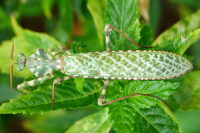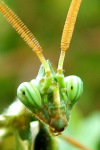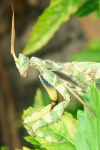Phylum Arthropoda (Arthropods) ➔ Subphylum Hexapoda (Hexapods) ➔ Class Insecta (Insects) ➔ Order Mantodea (Mantids) ➔ Family Empusidae
Blepharopsis mendica (Fabricius, 1775)
Kleine Teufelsblume Thistle Mantis
Synonyms and other combinations:
Mantis mendica Fabricius, 1775 |

Blepharopsis mendica (Fabricius, 1775) Kleine Teufelsblume Thistle Mantis
Blepharopsis mendica, male
ES, Fuerteventura, Costa Calma; 2008-02-22 14:54:44
Image number: 215
male
ES, Fuerteventura, Costa Calma
2008-02-22 14:54:44

Blepharopsis mendica (Fabricius, 1775) Kleine Teufelsblume Thistle Mantis
Blepharopsis mendica, male
ES, Fuerteventura, Costa Calma; 2008-02-22 14:55:00
Image number: 216
male
ES, Fuerteventura, Costa Calma
2008-02-22 14:55:00

Blepharopsis mendica (Fabricius, 1775) Kleine Teufelsblume Thistle Mantis
Blepharopsis mendica, male
ES, Fuerteventura, Costa Calma; 2008-02-22 14:56:11
Image number: 217
male
ES, Fuerteventura, Costa Calma
2008-02-22 14:56:11

Blepharopsis mendica (Fabricius, 1775) Kleine Teufelsblume Thistle Mantis
Blepharopsis mendica, male
ES, Fuerteventura, Costa Calma; 2008-02-22 15:52:32
Image number: 218
male
ES, Fuerteventura, Costa Calma
2008-02-22 15:52:32
Further vernacular names:
Devils Flower Mantis, Egyptian Flower Mantis
Classification:
Blepharopsis mendica belongs to the subfamily Blepharodinae.
Verbreitung:
Canary Islands; North Africa east to South Asia (India, Pakistan); from Turkey south to Tschad, Sudan and Somalia.
Habitat:
Preferably in dry, semi-desert areas with small shrubs.
Description:
The females of the Thistle Mantis (
Blepharopsis mendica) reach a body length up to 7 cm, the slightly smaller males up to 6 cm. Males and females can be distinguished by the shape of the antennae. Antennae are filiform in the female, a little longer and double combed in male.
Biology:
Blepharopsis mendica is a predator that feeds mainly on insects.



